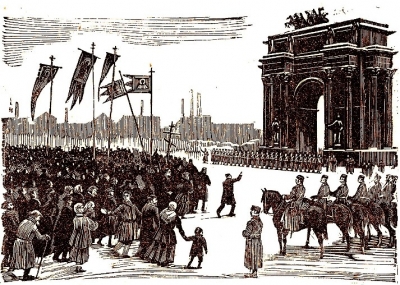
In 1905, Russia witnessed a wave of unrest that spread through the whole empire. The Revolution of 1905 was triggered by many reasons. The ordinary people suffered greatly from economic hardships, and they were angry with the regime of the tsar.
Population in the big cities had doubled because of industrialization. Overcrowding and pollution put a strain on the living conditions. There was not enough food to support the increasing urban population, and the living and working conditions were horrible for the workers as well as peasants. Anger and discontent grew among the people, pausing a threat to the regime.
On January 22, 1905, a huge gathering of people, mostly workers, marched to the winter palace of Tsar Nicholas II who was away at the time. The tsar had given orders not to shoot at the people, but the troops were unnerved by the huge numbers and opened fire. Hundreds were killed and wounded. This event came to be known as ‘Bloody Sunday’, and later triggered the Russian Revolution of 1905.
The defeat in Russia’s war with Japan also added fuel to the fire. The tsar had to sign a humiliating peace treaty, and this defeat to an Asian power was widely seen as an embarrassment and strengthened the perception that the tsarist government was weak.
A series of strikes broke out everywhere in the country, threatening the already weak economy. Nicholas II was forced to agree to bring in reforms, and he promised to implement them through the Russian parliament. But he had no intention to give up his grip on power, and dissolved the parliament. The 1905 Revolution did not bring in anything significant, but it caused the tsar to lose his people’s trust.
Picture Credit : Google




